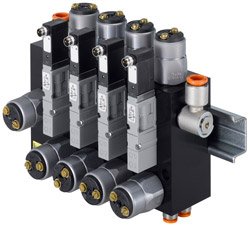
Posted to News on 26th Oct 2016, 19:12
Pneumatic valves for SIL1 or SIL2 safety control systems
Burkert Fluid Control Systems has developed a series of innovative safety valves that can be incorporated into new designs or retrofitted to existing control systems. This will be of particular interest to industries with highly automated processes, such as food and beverage or pharmaceuticals, facing challenges in terms of maintaining a safe environment and complying with current regulations and standards.

Increasing levels of automation in industrial processes has brought with it higher levels of safety and reliability. This has led to, among other things, the adoption of the European Union's Machinery Directive 2006/42/EC and a number of standards such as functional safety standard IEC 62061 (EN 62061). Compliance with the Directive and standard requires certain Safety Integrity Levels (SIL) or Performance Levels (PL) to be achieved, which, in turn, places requirements on safety-related control systems and components with regard to fault detection, redundancy and reliability.
Essentially, plant manufacturers and operators are required to assess the safety of their equipment and, if necessary, make improvements to bring it within compliance. One of the crucial aspects of this evaluation is the provision of emergency valves and stop procedures that prevent harm in the event of an employee intervening in a process.
Safety circuits have very specific requirements, especially in terms of wiring and redundancy of components. In a simple example, an emergency stop circuit will have two sets of contacts in the pushbutton, which are hard-wired to a safety relay or safety PLC, which, in turn, is hard-wired to contacts that stop the process. This sort of arrangement would be classified as PLc or SIL1, which would be suitable for low-level risks.
If the plant risk assessment has identified a higher category for a particular process, then it will be necessary to improve the reliability of the safety circuit. This can be done by introducing additional redundancy, which, in the example, above would be the addition of a control valve that could shut down the process in question in the event of the original contacts failing.
Safety-related shut-off
Many automated processes use pneumatic valve islands, connected to PLCs, to maintain the production process, and any safety-related circuits are separate from the valve island. In the wake of the introduction of EN ISO 13849, the international standard covering safety-related parts of control systems, Burkert has created two new valve types that could be fitted to new equipment or retrofitted to an existing valve island and used for a safety-related shut-off, thanks to the additional wiring that enables the valve to be connected directly to a safety relay.
This innovation enables plant managers to ensure their control structures meet the requirements for PLc or SIL1 with a compact product and minimal changes to the circuit. The only addition to the control cabinet is a safety relay, if one is not already present, which keeps both costs and space to a minimum.
Redundancy valve block
The second addition to the Burkert range is the redundancy valve block Type MKRS, which can be installed in more demanding applications that require a higher level of safety. The introduction of a redundancy valve block will enable PLc or SIL2 to be achieved, which can apply to many applications in the hygienic sector where clean-in-place (CIP) procedures are used.
For example, in processes where an inspection hatch can be opened for maintenance, it is essential that the process must be stopped if a cover is removed at an inappropriate time. Under normal circumstances the safety valve on the pneumatic valve island will stop the process but, in situations where there is an increased risk, the redundancy block is positioned so that if the safety valve fails to operate, then the process will be stopped by the Type MKRS valve.
Equally of use to process engineers designing new systems, this is a very compact option that can also easily be fitted to new systems or integrated into existing control systems without affecting the process control programming. For designers and OEMs, these new innovations from Burkert offer excellent reliability and minimal impact on current designs while delivering increased safety levels without requiring significantly more space for the control system hardware.
Follow the links for more information about the new redundancy valve block Type MKRS.
Fluid Control Centre
1 Bridge End
GL7 1QY
UNITED KINGDOM
+44 (0)1285 648720






























